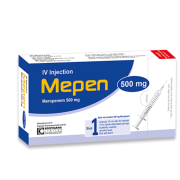Meropex IV Injection or Infusion
Meropenem Trihydrate
Indications
Meropex is indicated for treatment in adults and children for the following infections caused by single or multiple bacteria sensitive to Meropex.
- Pneumonia and Nosocomial Pneumonia
- Urinary Tract Infections
- Intra-abdominal Infections
- Gynaecological Infections, such as endometritis and pelvic inflammatory disease
- Skin and Skin Structure Infections
- Meningitis
- Septicaemia
- Pulmonary infections in cystic fibrosis
- Empiric treatment for presumed infections in patients with febrile neutropenia.
Pharmacology
Meropenem is a carbapenem antibiotic for parenteral use . It exerts its bactericidal action by interfering with bacterial cell wall synthesis. It penetrates bacterial cell walls, its high level of stability to all serine beta-lactamases and its marked affinity for the Penicillin Binding Proteins (PBPs.). It shows potent bactericidal activity against a broad spectrum of Gram-positive and Gram-negative, aerobic and anaerobic bacteria.
Dosage
The dosage and duration of therapy shall be established depending on type, severity of infection and the condition of the patient. The recommended daily dosage is as follows-
Adults:
- The usual dose is 500 mg to 1 gm by intravenous administration every 8 hours.
- Pneumonia, urinary tract infections, gynaecological infections such as endometritis, pelvic inflammatory disease, skin and skin structure infections: 500 mg IV every 8 hours.
- Nosocomial pneumonias, peritonitis, presumed infections in neutropenic patients and septicaemia: 1 g IV every 8 hours.
- Intra-abdominal infections: 500 mg to 1 gm every 8 hours.
- Cystic fibrosis: Upto 2 gm every 8 hours.
- Meningitis: 2 gm IV every 8 hours.
Children:
- 3 months to 12 years: 10 to 40 mg/kg intravenously every 8 hours depending on type and severity of infection, susceptibility of the pathogens and the condition of the patient.
- Intra-abdominal infections: 20 mg/kg every 8 hours.
- Cystic fibrosis (4-18 years): 25-40 mg/kg every 8 hours.
- Meningitis: 40 mg/kg IV every 8 hours.
- Febrile neutropenia: 20 mg/kg every 8 hours.
- Children over 50 kg weight: use adult dosage.
- There is no experience in children with hepatic or renal impairment.
Administration
Meropenem should be administered by intravenous Infusion over approximately 15-30 minutes or as intravenous bolus (5 to 20 ml) over approximately 3-5 minutes
* চিকিৎসকের পরামর্শ মোতাবেক ঔষধ সেবন করুন‘
Interaction
Probenecid competes with Meropex for active tubular secretion and thus inhibits the renal excretion, with the effect of increasing the elimination half-life and plasma concentration of meropenem. Meropex may reduce serum valproic acid levels. Sub therapeutic levels may be reached in some patients.
Contraindications
Meropenem is contraindicated in patients who have demonstrated hypersensitivity to this product.
Side Effects
Meropex is generally well tolerated. Side effects like inflammation, thrombophlebitis, pain at the site of injection, skin reactions like rash, pruritus, urticaria, abdominal pain, nausea, vomiting, diarrhea, headache may occur.
Pregnancy & Lactation
Pregnancy Category B. There are no adequate and well-controlled studies in pregnant women. So this drug should be used during pregnancy only if clearly needed. Because many drugs are excreted in human milk, caution should be exercised when Meropenem is administered to a nursing woman.
Precautions & Warnings
If an allergic reaction to Meropex occurs, the drug should be discontinued and appropriate measures taken. Use of Meropex in patients with hepatic disease should be made with careful monitoring of transaminase and bilirubin levels.
Use in Special Populations
Renal impairment: Dosage should be reduced in patients with creatinine clearance less than 51 ml/min.
Hepatic impairment: No dosage adjustments are necessary with impairment of liver function. Hemodialysis patients should receive Meropex after dialysis has been completed.
Elderly: No dosage adjustments are necessary in elderly patients unless creatinine clearance is <51 ml/min.
Use in Children: Efficacy and tolerability in infants under 3 months have not been established.
Overdose Effects
Accidental overdose could occur during therapy, particularly in patients with renal impairment. Treatment of overdose should be symptomatic. In normal individuals, rapid renal elimination will occur; in subjects with renal impairment, haemodialysis will remove Meropex and its metabolite.
Therapeutic Class
Other beta-lactam Antibiotics
Reconstitution
Preparation of solution:
Intravenous bolus Administration: Reconstitute Meropex (500 mg or 1 g) with sterile water for injection. Shake to dissolve and to obtain solution which is clear and colorless or pale yellow.
Intravenous infusion administration: Meropex for intravenous infusion may be directly constituted with a compatible infusion fluid and then further diluted (50 to 200 ml) with the compatible infusion fluid, as needed.
Meropex is compatible with the following infusion fluids: 0.9% sodium chloride intravenous infusion, 5% or 10% glucose intravenous infusion, 5% glucose intravenous infusion with 0.02% sodium bicarbonate, 5% glucose and 0.9% sodium chloride intravenous infusion, 5% glucose with 0.225% sodium chloride intravenous infusion, 5% glucose with 0.15% potassium chloride intravenous infusion, 2.5% and 10% mannitol intravenous infusion, normosol-M in 5% glucose intravenous infusion.
The use of freshly reconstituted solution is recommended. However, it maintains potency for up to 3 hours at up to 25oC or 13 hours at up to 5oC
Storage Conditions
Vial store in a cool, dry place (below 30oC), away from light & moisture. Keep out of the reach of children.

